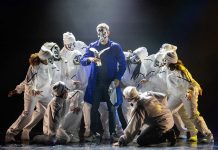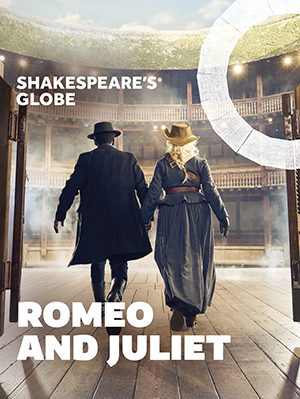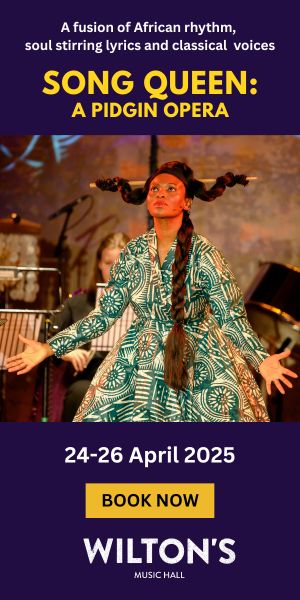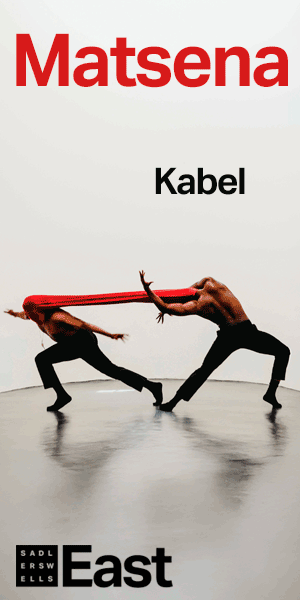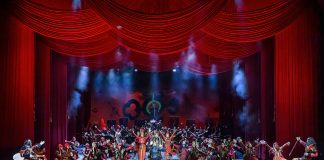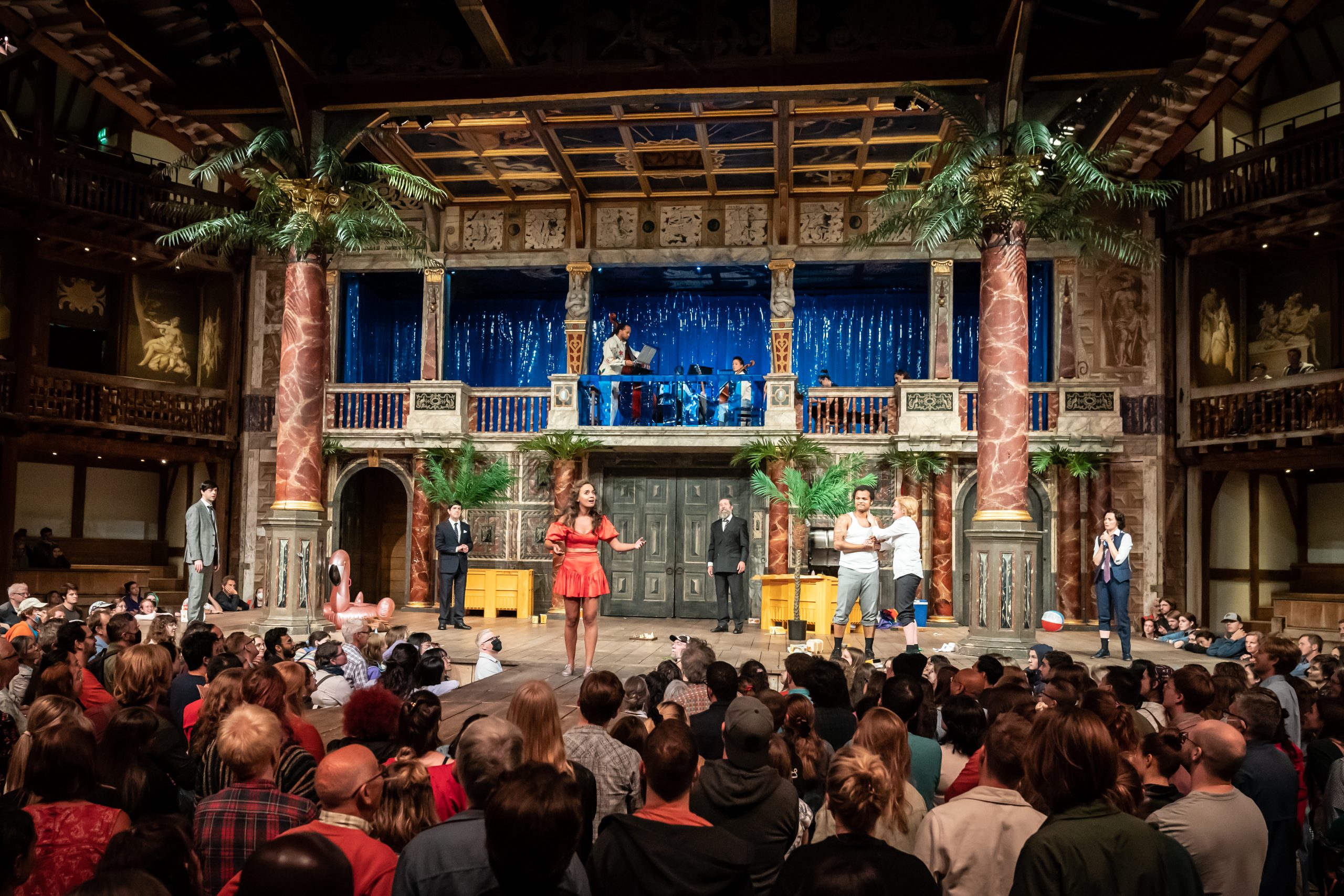
I have lived in London for over 20 years, and this was my first time experiencing the Globe, I know, I know…Really!!!
The summer evening air was filled with palpable excitement.
After collecting my essential bench cushion, I entered the theatre and was swept into a world of tradition, art, and spectacle. A festival feeling was brewing in the audience, who were waiting to be bathed in Shakespearean prose.
On the thrust stage, palm-tree leaves adorned two main pillars. A band of versatile musicians were situated on a balcony area above the stage. The set is sparse and open.
Let me set the scene… Prospero, a sorcerer, and the rightful Duke of Milan marooned on a deserted island with his daughter Miranda. He is aided by the spirit Ariel and the enslaved Caliban.
Ariel, played by the buoyant Rachel Hannah Clarke, dressed as a sailor and with a fire hose in tow, sprays the audience with water, leading to squeals, fits of giggles and an infectious party atmosphere.
Next enters a ‘booze cruise’, in the guise of a Perspex cube, filled with balloons, party hats and oh yes, Tory cabinet-looking actors – reminiscent of the Covid party gate debacle. The boat is returning from Tunis to Italy after a successful nuptial. The revellers include the King of Naples – Alonzo, his brother Sebastian, the usurper Antonio, the optimistic Francisco, and the loyal Gonzalo.
We are then privy to more colourful proceedings: a megaphone, a flamingo-shaped rubber dingy, a sun umbrella, and an industrial barbeque.
The fiercely curious and sun-kissed Miranda enters and the yellow, speedo-trunked Prospero entertains us. Images of Club Tropicana – Wham pop promos and Love Island fill my head. Their dialogue is speedy, efficient, and drilled: serving the exposition and fulfilling the characterisation of a freedom-seeking Miranda and a controlling Prospero.
The suffering Caliban is summoned, he is enslaved, labelled a monster, othered, and colonised. Shakespeare’s text gives rise to the themes of domination and submission and in reflection highlights the European appetite for colonialism and imperialism at whatever cost.
The Tempest was traditionally seen as a comedy, but in later interpretations, commentators viewed the play as lying somewhere between comedy and tragedy. The Globe’s version went full force back to the comedic iteration of the bard’s play. The pace is quick, playful and slapstick in its aesthetic and movement style. The music soundscape is episodic, minimal and features 17th-century music interludes and contemporary songs/chants.
The king of Naples and the aforementioned court are shipwrecked on Prospero’s Island. Gonzalo, played by the standout Peter Bourke, offers support and encouragement in finding Alonzo’s missing son, Ferdinand. Bourke’s performance is delivered with great energy, clarity, and levity.
The Globe’s version went full force back to the comedic iteration of the bard’s play.
Meanwhile, the animated and unabashed Sebastian emanates a Russell Brand-like quality. Both he and Antonio plot to murder Alonso, thus initiating a power grab.
The functional / DIY aesthetic is purposeful and seen in most transitions, the cast repurposes huge yellow crates; like giant sandcastles locomoting the island. The crates house props, rubber ducks and oh yes cast members!
The actors often break the fourth wall, engaging the audience and using contemporary references, locations, and phrases, e.g. call and response singing. This is evident in the characters Caliban, Stefano, (Alonso’s drunken butler) and Trinculo, (the court jester). Their mission is to overthrow Prospero and take the island. Stefano and Trinculo are the epitomai of heightened humour and slapstick comedy, especially whilst employing Harry Potter disguises!
Miranda and Ferdinand find each other and pledge their love to one another. Although well executed and banter-fuelled, the chemistry between the two is more akin to friendly flatmates than a couple infatuated with each other.
Act two showcases the omnipresent Prospero, who uses props to decorate the set like a colourful nursery playpen. Facilitated by the all-knowing Aerial, Prospero plots revenge on his island ‘guests’ and magically toys with their emotional and physical states.
Ariel uses Spirits to trap Alonso and his courtiers at a bacchanal feast of fast food and carnival dancing.
Antonio and Sebastian’s plot to kill Alonso, Francisco, and Gonzalo is uncovered.
Love blossoms for Miranda and Ferdinand, and Prospero confronts his brother and Alonso, revealing his true identity, as the rightful Duke of Milan. He then releases Ariel and Caliban from their enslavement. Prospero encompasses these events in his ending soliloquy, which is filled with pathos, forgiveness, and gravitas.
Although the Tempest is a clear audience pleaser and is not without merit, I question the comedic direction which leaves the performances lacking character arcs. I wanted more investigation of the themes of revenge, manipulation, and loss. I needed to viscerally feel the darkness, despair, mysticism, and danger to maximise the impact of Shakespeare’s text and juxtapose the fun-filled rollercoaster of a production.
I was enthralled by Miranda’s concluding words, (played by Nadi Kemp-Sayfi), and felt the wonder of them. The prose is a living testament and the perfect antidote to some of the world’s glaring problems… “How many goodly creatures are there here! How beauteous mankind is! O brave new world That has such people isn’t!”




















